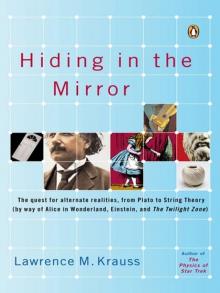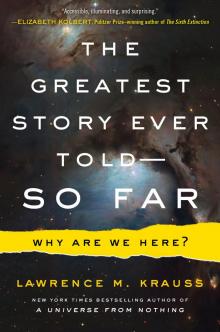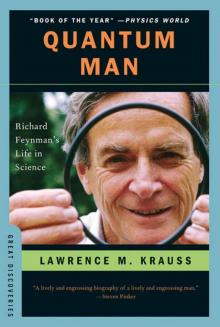- Home
- Lawrence M. Krauss
The Greatest Story Ever Told—So Far Page 4
The Greatest Story Ever Told—So Far Read online
Page 4
• • •
Within a decade, a young Scottish theoretical physicist, down on his luck, took the next step.
Chapter 3
* * *
THROUGH A GLASS, LIGHTLY
Nothing is too wonderful to be true, if it be consistent with the laws of nature; and in such things as these, experiment is the best test of such consistency.
—FARADAY, LABORATORY JOURNAL ENTRY #10,040 (MARCH 18, 1849)
The greatest theoretical physicist of the nineteenth century, James Clerk Maxwell, whom Einstein would later compare to Newton for his impact on physics, was coincidentally born in the same year that Michael Faraday made his great experimental discovery of induction.
Like Newton, Maxwell also began his scientific career fascinated by color and light. Newton had explored the spectrum of visible colors into which white light splits when traversing a prism, but Maxwell, while still a student, investigated the reverse question: What is the minimal combination of primary colors that would reproduce for human perception all the visible colors contained in white light? Using a collection of colored spinning tops, he demonstrated that essentially all colors we perceive can result from mixtures of red, green, and blue—a fact familiar to anyone who has plugged RGB cables into a color television. Maxwell used this realization to produce the world’s first, rudimentary color photograph. Later he became fascinated with polarized light, which results from light waves whose electric and magnetic fields oscillate only in certain directions. He sandwiched blocks of gelatin between polarizing prisms and shined light through them. If the two prisms allowed only light to pass that was polarized in different perpendicular directions, then if one was placed behind the other, no light would make it through. However, if stresses were present in the gelatin, then the light could have its axis of polarization rotated as it passed through the material, so that some light might then make it through the second prism. By searching for such fringes of light passing through the second prism, Maxwell could explore for stresses in the material. This has become a useful tool today for exploring possible material stresses in complex structures.
Even these ingenious experiments do not adequately represent the power of Maxwell’s voracious intellect or his mathematical ability, which were both manifest at a remarkably early age. Tragically, Maxwell died at the age of forty-eight and had precious little time to accomplish all that he did. His inquisitive nature was reflected in a passage his mother added to a letter from his father to his sister-in-law when Maxwell was only three:
He is a very happy man, and has improved much since the weather got moderate; he has great work with doors, locks, keys, etc., and “show me how it doos” is ever out of his mouth. He also investigates the hidden course of streams and bell-wires, the way the water gets from the pond through the wall.
After his mother’s untimely death (of stomach cancer, to which Maxwell would later succumb at the same age), his education was interrupted, but by the age of thirteen he had hit his stride at the prestigious Edinburgh Academy, where he won the prize for mathematics, and also for English and poetry. He then published his first scientific paper—concerning the properties of mathematical curves—which was presented at the Royal Society of Edinburgh when he was only fourteen.
After this precocious start, Maxwell thrived at university. He graduated from Cambridge, becoming a fellow of the college within a year after graduation, which was far sooner than average for most graduates. He left shortly thereafter and returned to his native Scotland to take up a chair in natural philosophy in Aberdeen.
At only twenty-five, he was head of a department and teaching fifteen hours a week plus an extra free lecture for a nearby college for working men (something that would be unheard of for a chaired professor today, and something that I find difficult to imagine doing myself and still having any energy left for research). Yet Maxwell nevertheless found time to solve a problem that was two centuries old: How could Saturn’s rings remain stable? He concluded that the rings must be made of small particles, which garnered him a major prize that had been set up to encourage an answer to this question. His theory was confirmed more than a hundred years later when Voyager provided the first close-up view of the planet.
You would think that, after his remarkable output, he would have been able to remain secure in his professorship. However, in 1860, the same year that he was awarded the Royal Society’s prestigious Rumford Medal for his work on color, the college where he lectured merged with another college and had no room for two professors of natural philosophy. In what must surely go down in history as one of the dumbest academic decisions ever made (and that is a tough list to top), Maxwell was unceremoniously laid off. He tried to get a chair in Edinburgh, but again the position was given to another candidate. Finally, he found a position down south, at King’s College, London.
One might expect Maxwell to have been depressed or disconsolate because of these developments, but if he was, his work reflected no signs of it. The next five years at King’s were the most productive period in his life. During this time he changed the world—four times.
The first three contributions were the development of the first light-fast color photograph; the development of the theory of how particles in a gas behave (which helped establish the foundations of the field now known as statistical mechanics—essential for understanding the properties of matter and radiation); and finally his development of “dimensional analysis,” which is perhaps the tool most frequently used by modern physicists to establish deep relationships between physical quantities. I just used it last year, for example, with my colleague Frank Wilczek, to demonstrate a fundamental property of gravity relevant to understanding the creation of our universe.
Each contribution on its own would have firmly established Maxwell among the greatest physicists of his day. However, his fourth contribution ultimately changed everything, including our notions of space and time.
During his period at King’s, Maxwell frequented the Royal Institution, where he came in contact with Michael Faraday, who was forty years older but still inspirational. Perhaps these meetings encouraged Maxwell to return his focus to the exciting developments in electricity and magnetism, a subject he had begun to investigate five years earlier. Maxwell used his considerable mathematical talents to describe and understand the phenomena explored by Faraday. He began by putting Faraday’s hypothesized lines of force on a firmer mathematical footing, which allowed him to explore in more depth Faraday’s discovery of induction. Over the dozen years between 1861 and 1873, Maxwell put the final touches on his greatest work, a complete theory of electricity and magnetism.
To do this, Maxwell used Faraday’s discovery as the key to revealing that the relationship between electricity and magnetism is symmetrical. Oersted’s and Faraday’s experiments had shown, simply, that a current of moving charges produces a magnetic field; and that a changing magnetic field (produced by moving a magnet or simply turning on a current to produce a magnet) produces an electric field.
Maxwell first expressed these results mathematically in 1861, but soon realized that his equations were incomplete. Magnetism appeared to be different from electricity. Moving charges create a magnetic field, but a magnetic field can create an electric field even without moving—just by changing. As Faraday discovered, turning on a current, which produces a changing magnetic field as the current ramps up, produces an electric force that causes a current to flow in another nearby wire.
Maxwell recognized that to make a complete and consistent set of equations for electricity and magnetism he had to add an extra term to the equations, representing what he called a “displacement current.” He reasoned that moving charges, namely a current, produce a magnetic field, and moving charges represent one way to produce a changing electric field (since the field from each charge changes in space as the charge moves along). So, maybe, a changing electric field—one that gets stronger or weaker—in a region with no charges in motion, could produce a m
agnetic field.
Maxwell envisioned that if he hooked up two parallel plates to opposite poles of a battery, each plate would get charged with an opposite charge as current flowed from the battery. This would produce a growing electric field between the plates and would also produce a magnetic field around the wires connected to the plates. For his equations to be completely consistent, Maxwell realized, the increasing electric field between the plates should also produce a magnetic field in that empty space between the plates. And that field would be the same as any magnetic field produced by a real current flowing through that space between the plates.
So Maxwell altered his equations by adding a new term (displacement current) to produce mathematical consistency. This term effectively behaved like an imaginary current, flowing between the plates producing a changing electric field identical in magnitude to the actual changing electric field in the empty space between the plates. It also was the same as the magnetic field that a real current would produce if it flowed between the plates. Such a magnetic field does in fact arise when you perform the experiment with parallel plates, as undergraduates demonstrate every day in physics laboratories around the world.
Mathematical consistency and sound physical intuition generally pay off in physics. This subtle change in the equations may not seem like much, but its physical impact is profound. Once you remove real electric charges from the picture, it means that you can describe everything about electricity and magnetism entirely in terms of the hypothetical “fields” that Faraday had relied upon purely as a mental crutch. The connections between electricity and magnetism can thus be simply stated: A changing electric field produces a magnetic field. A changing magnetic field produces an electric field.
Suddenly the fields appear in the equations as real physical objects in their own right and not merely as a way to quantify the force between charges. Electricity and magnetism became inseparable. It is impossible to talk about electrical forces alone because, as I will shortly show, one person’s electric force is another person’s magnetic force, depending on the circumstances of the observer, and whether the field is changing in his frame of reference.
We now refer to electromagnetism to describe these phenomena, for a good reason. After Maxwell, electricity and magnetism were no longer viewed as separate forces of nature. They were different manifestations of one and the same force.
Maxwell published his complete set of equations in 1865 and later simplified them in his textbook of 1873. These would become famous as the four Maxwell’s Equations, which (admittedly rewritten in modern mathematical language) adorn the T-shirts of physics undergraduates around the world today. We can thus label 1873 as establishing the second great unification in physics, the first being Newton’s recognition that the same force governed the motion of celestial bodies as governed falling apples on Earth. Begun with Oersted’s and Faraday’s experimental discoveries, this towering achievement of the human intellect was completed by Maxwell, a mild-mannered young theoretical physicist from Scotland, exiled to England by the vicissitudes of academia.
Gaining a new perspective on the cosmos is always—or should be—immensely satisfying. But science adds an additional and powerful benefit. New understanding also breeds tangible and testable consequences, and often immediately.
So it was with Maxwell’s unification, which now made Faraday’s hypothetical fields literally as real as the nose on your face. Literally, because it turns out you couldn’t see the nose on your face without them.
Maxwell’s genius didn’t end just with codifying the principles of electromagnetism in elegant mathematical form. He used the mathematics to unravel the hidden nature of that most fundamental of all physical quantities—which had eluded the great natural philosophers from Plato to Newton. The most observable thing in nature: light.
Consider the following thought experiment. Take an electrically charged object and jiggle it up and down. What happens as you do this?
Well, an electric field surrounds the charge, and when you move the charge, the position of the field lines changes. But, according to Maxwell, this changing electric field will produce a magnetic field, which will point in and out of the paper as shown below:
Here the field line pointing into the paper has a cross (the back of an arrow), and that pointing out of the paper has a dot (the tip of an arrow). This field will flip direction as the charge changes the direction of its motion from upward to downward.
But we should not stop there. If I keep jiggling the charged object, the electric field will keep changing, and so will the induced magnetic field. But a changing magnetic field will produce an electric field. Thus there are new induced electric field lines, which point vertically, changing from up to down as the magnetic field reverses its sign. I display the electric field line to the right only for lack of space, but the mirror image will be induced on the left-hand side.
But that changing electric field will in turn produce a changing magnetic field, which would exist farther out to the right and left of the diagram, and so on.
Jiggling a charge produces a succession of disturbances in both electric and magnetic fields that propagate outward, with the change in each field acting as a source for the other, due to the rules of electromagnetism as Maxwell defined them. We can extend the picture shown above to a 3-D image that captures the full nature of the changing as shown below:
We see a wave of electric and magnetic disturbances, namely an electromagnetic wave moving outward, with electric and magnetic fields oscillating in space, and time, and with the two fields oscillating in directions that are perpendicular to each other and also the direction of the wave.
Even before Maxwell had written down the final form of his equations, he showed that oscillating charges would produce an electromagnetic wave. But he did something far more significant. He calculated the speed of that wave, in a beautiful and simple calculation that is probably my favorite derivation to show undergraduates. Here it is:
We can quantify the strength of an electric force by measuring its magnitude between two charges whose magnitude we already know. The force is proportional to the product of the charges. Let’s call the constant of proportionality A.
Similarly we can quantify the strength of the magnetic force between two electromagnets, each with a current of known magnitude. This force is proportional to the product of the currents. Let’s call the constant of proportionality in this case B.
Maxwell showed that the speed of an electromagnetic disturbance that emanates from an oscillating charge can be rendered precisely in terms of the measured strength of electricity and the measured strength of magnetism, which are determined by measuring the constants A and B in the laboratory. When he used the data then available for the measured strength of electricity and the measured strength of magnetism and plugged in the numbers, he derived:
Speed of electromagnetic waves ≈ 311,000,000 meters per second
A famous story claims that when Albert Einstein finished his General Theory of Relativity and compared its predictions for the orbit of Mercury to the measured numbers, he had heart palpitations. One can only imagine, then, the excitement that Maxwell must have had when he performed his calculation. For this number, which may seem arbitrary, was well known to him as the speed of light. In 1849, the French physicist Fizeau had measured the speed of light, an extremely difficult measurement back then, and had obtained:
Speed of light ≈ 313,000,000 meters per second
Given the accuracy available at the time, these two numbers are identical. (We now know this number far more precisely as 299,792,458 meters per second, which is a key part of the modern definition of the meter.)
In his typical understated tone, Maxwell noted in 1862, when he first performed the calculation, “We can scarcely avoid the conclusion that light consists in the transverse undulations of the same medium which is the cause of electric and magnetic phenomena.”
In other words, light is an electromagnetic wav
e.
Two years later, when he finally wrote his classic paper on electromagnetism, he added somewhat more confidently, “Light is an electromagnetic disturbance propagated through the field according to electromagnetic laws.”
With these words, Maxwell appeared to have finally put to rest the two-thousand-year-old mystery regarding the nature and origin of light. His result came, as great insights often do, as an unintended by-product of other fundamental investigations. In this case, it was a by-product of one of the most important theoretical advances in history, the unification of electricity and magnetism into a single beautiful mathematical theory.
• • •
Before Maxwell, the chief source of wisdom came from a faith in divinity via Genesis. Even Newton relied upon this source for understanding the origin of light. After 1862, however, everything changed.
James Clerk Maxwell was deeply religious, and like Newton before him, his faith sometimes led him to make strange assertions about nature. Nevertheless, like the mythical character Prometheus before him, who stole fire from the gods and gave it to humans to use as a tool to forever change their civilization, so too Maxwell stole fire from the Judeo-Christian God’s first words and forever changed their meaning. Since 1873, generations of physics students have proudly proclaimed:
“Maxwell wrote down his four equations and said, Let there be light!”
Chapter 4
* * *
THERE, AND BACK AGAIN
He set the earth on its foundations; it can never be moved.

 Beyond Star Trek
Beyond Star Trek Hiding in the Mirror: The Quest for Alternate Realities, From Plato to String Theory (By Way of Alicein Wonderland, Einstein, and the Twilight Zone)
Hiding in the Mirror: The Quest for Alternate Realities, From Plato to String Theory (By Way of Alicein Wonderland, Einstein, and the Twilight Zone) The Greatest Story Ever Told—So Far
The Greatest Story Ever Told—So Far Quantum Man: Richard Feynman's Life in Science
Quantum Man: Richard Feynman's Life in Science